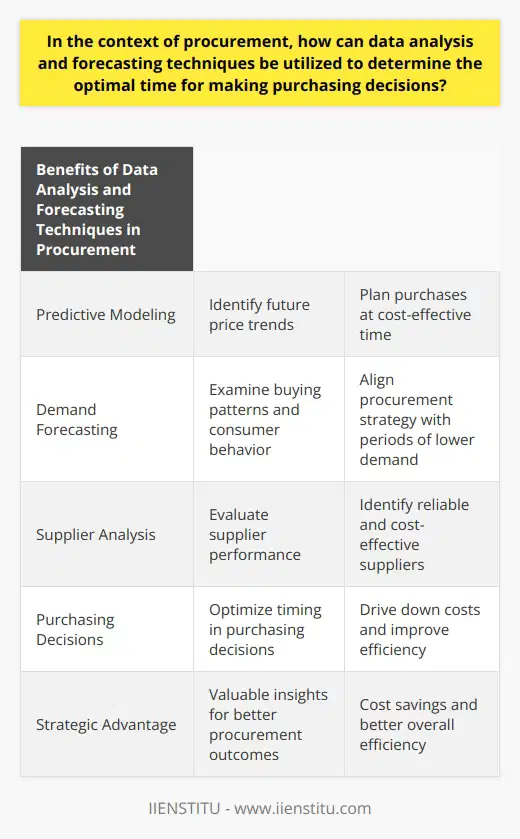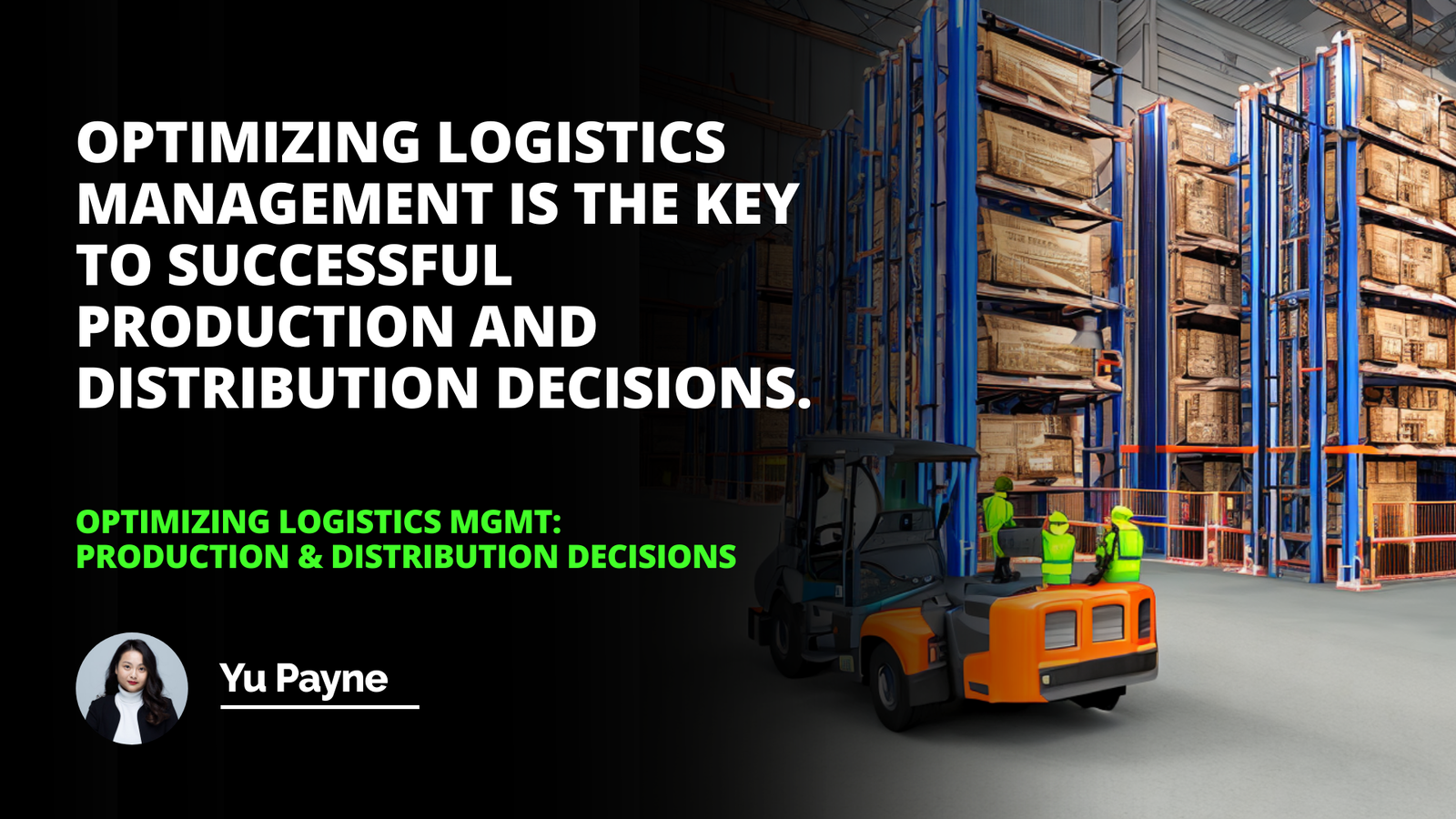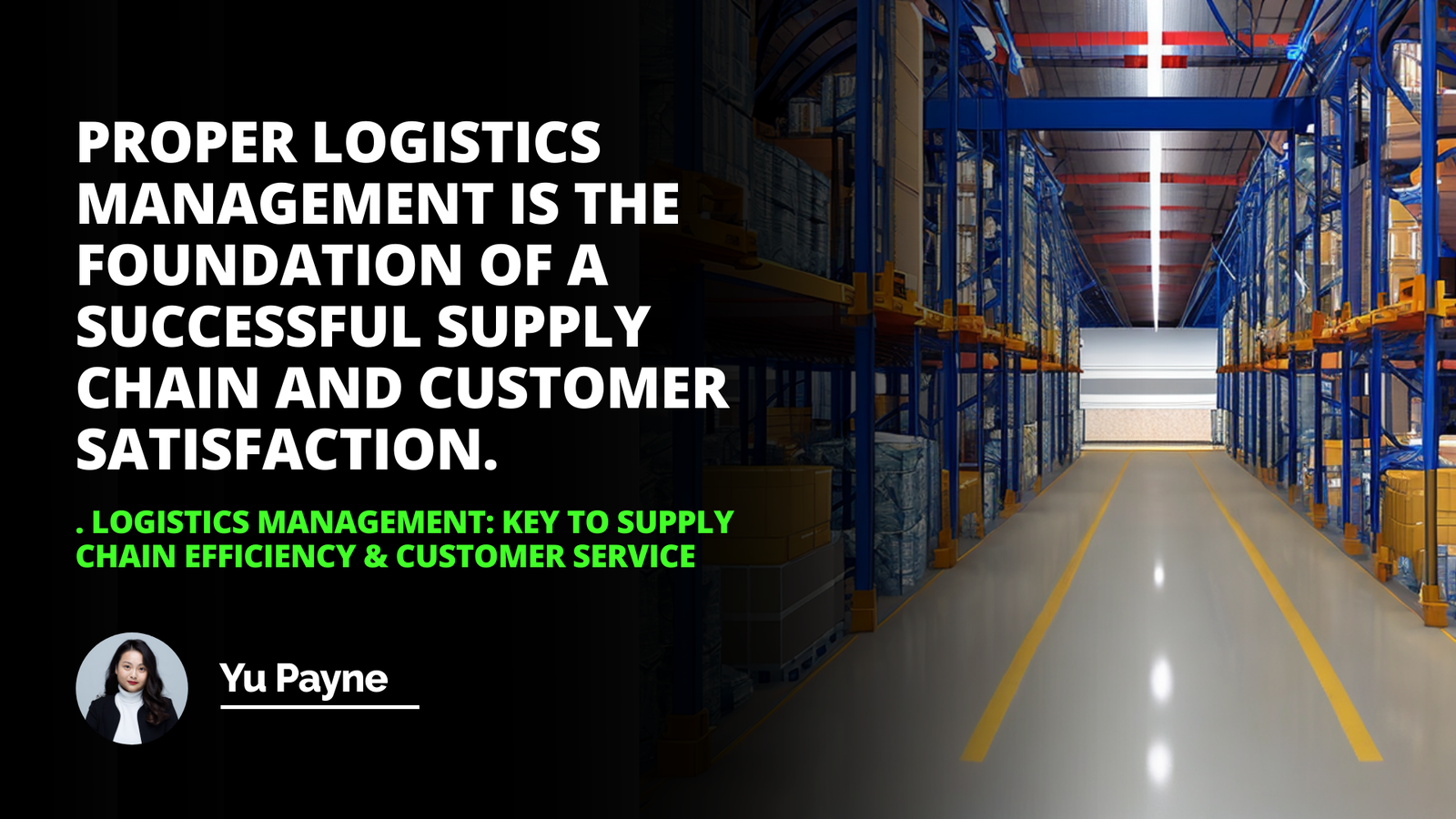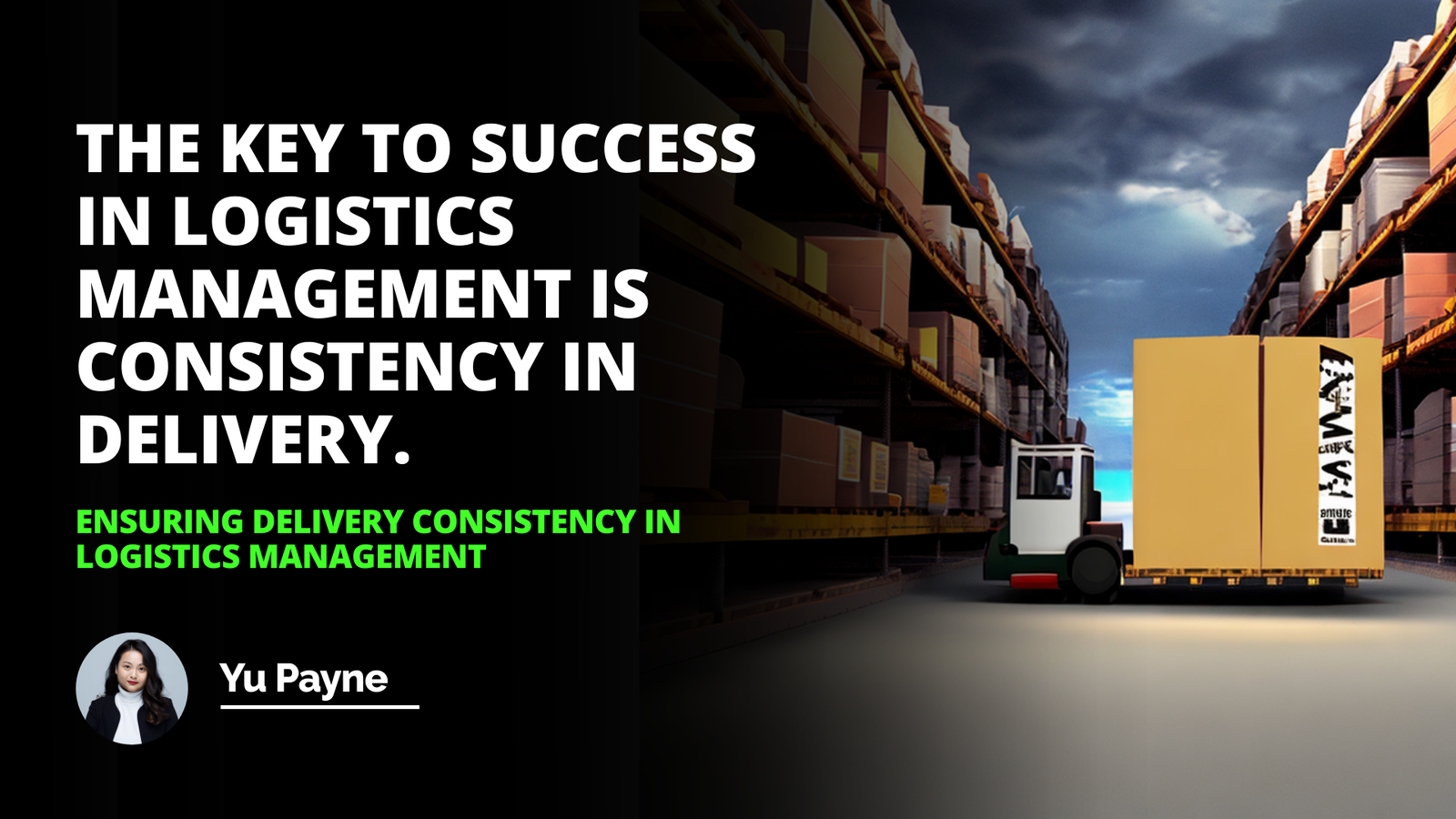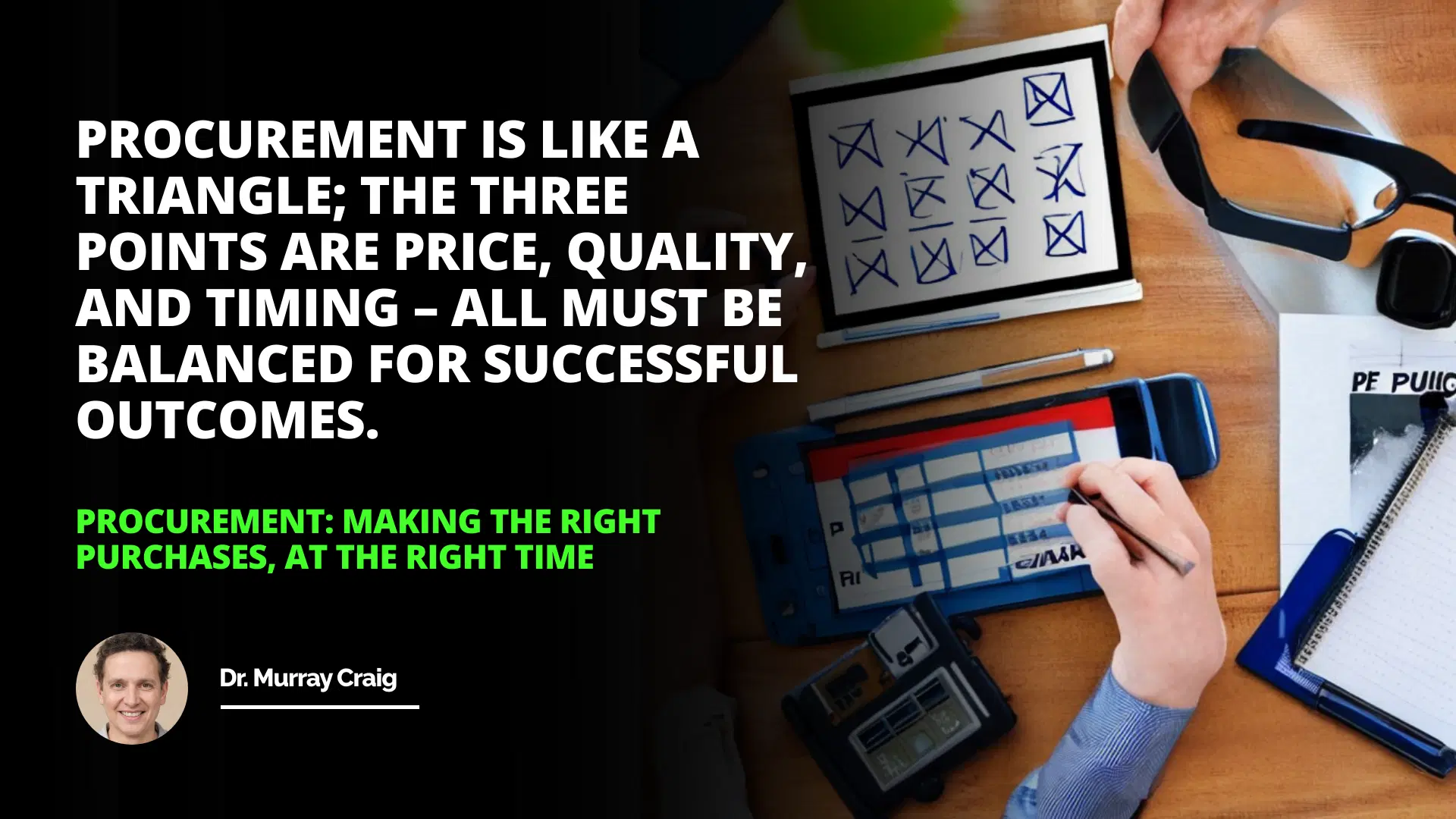
You know, I still remember when I first stepped into the world of procurement. It was a warm Monday morning, and as I walked into the office, the sheer complexity of the procurement process hit me like a wave. I thought to myself, "How hard can buying goods and services really be?" Little did I know, procurement is so much more than just purchases—it's the backbone of any successful business.
Important Components of Procurement
Challenges of Procurement
Strategies for Improved Procurement
The Essence of Procurement: More Than Just Buying
At its heart, procurement is about obtaining the right goods, services, or works from the best possible source, at the right price, quality, and time. It's an integral part of the supply chain, and when done effectively, it can drive significant cost savings and improve organizational efficiency.
Logistics Management İn Supply Chain Efficiency And Customer Service
Carload Freight Supply Chain Management Benefits Challenges Strategies
Systemic Approach For İnventory Control İn Logistics Management
Developing clear and detailed specifications of the products or services required is essential. This will help ensure that the final product or service meets the organization's needs.
A supplier must be qualified after assessing the quality, cost, and turnaround time.
Once the supplier has been identified, a contract can be developed to ensure a smooth procurement process.
Key Components of Effective Procurement
Over the years, I've come to understand that the success of any procurement process hinges on several vital components:
1- Developing Clear Specifications
It's crucial to articulate precisely what the organization needs. This means crafting detailed specifications for products or services, which serves as a blueprint for suppliers.
2- Qualifying Suppliers
Not every supplier is the right fit. Evaluating potential suppliers based on quality, cost, reliability, and turnaround time is essential. This step ensures that the supply chain remains robust and resilient.
3- Contract Development and Management
Once a supplier is selected, developing a comprehensive contract is the next step. This contract outlines expectations, responsibilities, and obligations, providing a framework for a successful partnership.
4- Performance Monitoring
Regularly assessing supplier performance against agreed-upon metrics helps in maintaining quality and fostering continuous improvement.
I recall an instance when our team overlooked the importance of performance monitoring. We assumed that once the contract was signed, everything would run smoothly. However, delays started cropping up, and quality began to slip. It was a hard lesson, but it taught us the value of ongoing oversight.
The Procurement Cycle
Understanding the procurement cycle is also fundamental:
Procurement is like a triangle. The three points are price, quality, and timing. All must be balanced for successful outcomes.
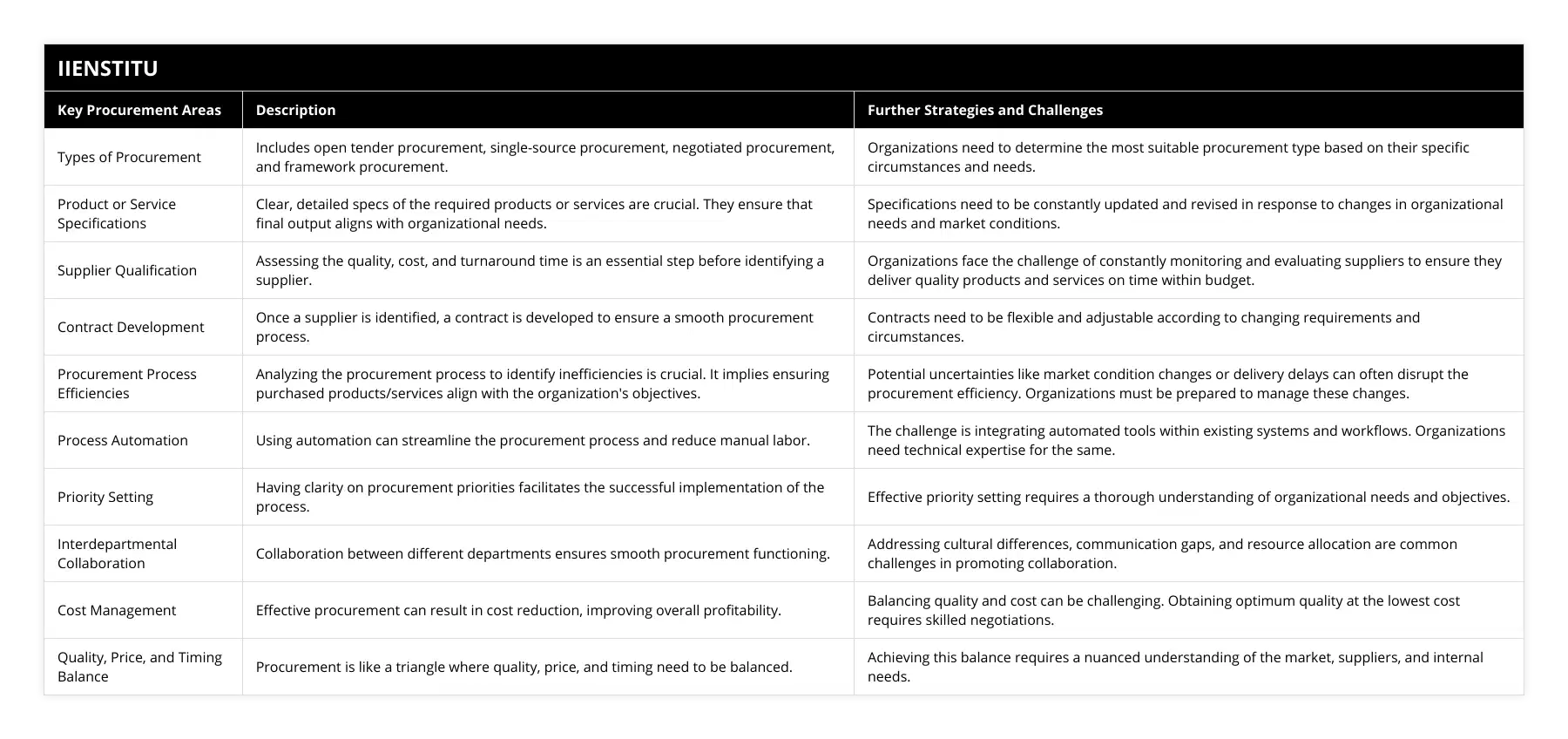
1- Identifying Needs
The process begins with recognizing what the organization requires.
2- Market Research
Investigating potential suppliers and market conditions.
3- Supplier Selection
Evaluating and choosing the best supplier based on predetermined criteria.
4- Purchase Order Issuance
Officially requesting the goods or services.
5- Expediting and Delivery
Ensuring timely delivery and addressing any issues that arise.
6- Receipt and Inspection
Verifying that the goods or services meet the specified requirements.
7- Payment Processing
Completing financial transactions efficiently.
8- Record Keeping
Maintaining accurate records for future reference and compliance.
By meticulously following each step, organizations can optimize supply chain management processes and mitigate risks.
Navigating Common Procurement Challenges
Procurement, while rewarding, is not without its challenges. Some of the common hurdles include:
Budget Limitations
Working within budget constraints can be tough, especially when quality is non-negotiable.
Supplier Reliability
Suppliers may sometimes fail to deliver on time or meet quality standards.
Regulatory Compliance
Ensuring that procurement practices comply with legal and ethical standards is paramount.
Technological Changes
Keeping up with the latest procurement technologies and integrating them into existing systems can be daunting.
Market Volatility
Fluctuations in market conditions can impact pricing and availability.
During one of my projects, we faced a sudden supplier bankruptcy. It threw a wrench in our plans, and we had to scramble to find an alternative. This experience highlighted the importance of having contingency plans and maintaining a diverse supplier base.
Strategies for Enhancing Procurement Efficiency
To overcome these challenges, organizations can adopt several strategies:
Leveraging Technology and Automation
E-Procurement Systems
Implementing e-procurement platforms can streamline the purchasing process, reduce errors, and enhance transparency.
Data Analytics
Utilizing data to gain insights into spending patterns and supplier performance helps in making informed decisions.
Building Strong Supplier Relationships
Collaborative Partnerships
Working closely with suppliers fosters trust and can lead to better terms and innovation.
Supplier Development Programs
Investing in suppliers' capabilities can improve quality and efficiency.
Implementing Best Practices
Standardizing Procedures
Establishing clear policies and procedures ensures consistency and compliance.
Continuous Training
Providing regular training for procurement staff keeps them updated on best practices and emerging trends.
Optimizing the Supply Chain Management Process
To optimize supply chain management processes, consider the following tips:
1- Adopt Lean Principles
Eliminating waste and focusing on value-added activities enhances efficiency.
2- Enhance Communication
Clear communication across all levels ensures that everyone is aligned.
3- Integrate Systems
Connecting procurement software with other systems like inventory management creates a seamless flow of information.
4- Monitor KPIs
Regularly tracking key performance indicators helps in identifying areas for improvement.
5- Engage in Strategic Sourcing
Looking beyond immediate needs and considering long-term objectives leads to better supplier selection.
By integrating these strategies, organizations can not only enhance procurement but also improve overall supply chain management effectiveness.
Focusing on Sustainability
With increasing awareness of environmental issues, incorporating sustainability into procurement is becoming crucial.
Eco-Friendly Purchasing
Choosing products and services that have a minimal environmental impact.
Ethical Sourcing
Ensuring that suppliers adhere to ethical labor practices.
By embracing sustainability, organizations not only contribute positively to the environment but also enhance their reputation.
The Human Element in Procurement
It's easy to get caught up in processes and systems, but at the end of the day, procurement is about people.
Negotiation Skills
Effective negotiation can lead to better prices and terms.
Relationship Building
Strong relationships with suppliers and internal stakeholders facilitate smoother operations.
Problem-Solving Abilities
Being able to think on your feet and resolve issues promptly is invaluable.
I once had a supplier who was consistently late with deliveries. Instead of immediately seeking a new supplier, I decided to visit them personally. We discussed the issues openly, and it turned out they were facing logistical challenges. By collaborating, we found solutions that improved their delivery times and strengthened our partnership.
The Procurement Triangle: An Equilibrium of Success
As mentioned earlier, procurement is like a triangle balancing price, quality, and timing. Neglecting any one of these can lead to suboptimal results.
Balancing Price and Quality
Cost-saving shouldn't come at the expense of quality. Finding the right balance ensures value for money.
Timing and Reliability
Timely deliveries are crucial. Delays can halt operations and incur additional costs.
Quality Assurance
Maintaining high-quality standards protects the organization's reputation and satisfies customer expectations.
The Future of Procurement
Looking ahead, several trends are shaping the future of procurement:
Digital Transformation
Artificial Intelligence (AI)
AI can automate routine tasks and provide predictive analytics.
Blockchain Technology
Enhances transparency and security in transactions.
Sustainable Procurement
Circular Economy Principles
Focusing on reuse and recycling within the supply chain.
Globalization and Risk Management
Diversifying Supply Chains
Reducing reliance on a single source to mitigate risks.
Geopolitical Considerations
Staying informed about global events that can impact procurement.
By staying ahead of these trends, organizations can ensure that their procurement practices remain competitive and effective.
Conclusion: Embracing Procurement as a Strategic Function
Procurement is no longer just an administrative task—it's a strategic function that can significantly impact an organization's success. By focusing on key components, navigating challenges proactively, and embracing new strategies and technologies, businesses can enhance their procurement processes.
Remember, procurement is like a triangle. The equilibrium of price, quality, and timing is essential for success. By maintaining this balance and continuously striving for improvement, organizations can achieve their objectives and gain a competitive edge.
References
1- Lysons, K., & Farrington, B. (2016). Purchasing and Supply Chain Management. Pearson.
2- Sollish, F., & Semanik, J. (2012). The Procurement and Supply Manager's Desk Reference. John Wiley & Sons.
3- Baily, P., Farmer, D., Crocker, B., Jessop, D., & Jones, D. (2015). Procurement Principles and Management. Pearson Education.
4- Porter, M. E. (1985). Competitive Advantage: Creating and Sustaining Superior Performance. Free Press.
5- Heizer, J., Render, B., & Munson, C. (2017). Operations Management: Sustainability and Supply Chain Management. Pearson.
Frequently Asked Questions
What strategies can be utilized to ensure that the right purchase is made at the right time?
The purpose of purchasing is to ensure that goods and services needed for the proper functioning of a business are acquired at the right time and price. Therefore, companies must have strategies to make the right purchase at the right time. These strategies can include using technology to monitor spending, thorough research of the market and the suppliers, and strict policies and procedures in place.
Technology can be utilized to help decision-makers with their purchasing process. For example, companies can use automated systems which track and monitor incoming requests and associated spending. This can help decision-makers ensure that purchases are made at the right time and not before or after necessity. Throughout this process, decision-makers should include stakeholders such as shareholders and suppliers to ensure the decisions are in all parties' best interests.
Decision-makers should also take the time to research the suppliers they are considering extensively. Buyers should ensure they choose the right supplier for their company's needs. An exhaustive review of the organization's financial position, customer service performance, supplier relationship, and organization capabilities helps buyers determine the right supplier. The buyer should also consider the supplier's impact on their business by assuming the supplier's past work performances and ability to be reliable.
In addition to these considerations, businesses need strict policies and procedures for purchasing. Companies should develop policies that allow decision-makers to make wise decisions regarding spending the business's funds. Policies should also include time frames in which to make decisions on purchases. These policies help to ensure that suitable investments are made promptly and limit the potential for potential mismanagement of funds.
Overall, businesses need effective strategies to ensure that the right purchases are made at the right time. These strategies include using technology effectively, researching suppliers, and implementing comprehensive policies and procedures. By utilizing these strategies, businesses can reduce the potential for mismanagement of funds and ensure that the right purchases are made at the right time.
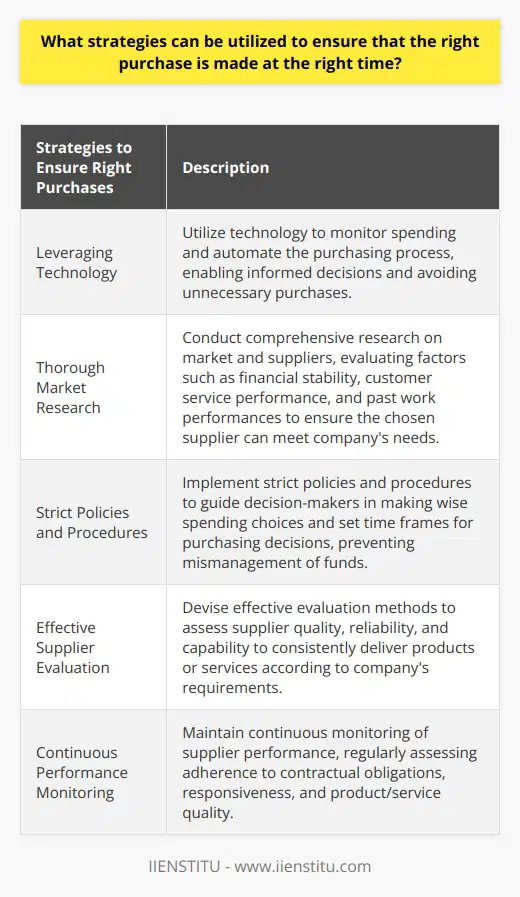
How can we ensure that procurement processes comply with government regulations?
Procurement is an inevitable process for all government organizations. Therefore, governments must implement and maintain effective procurement policies, procedures, and techniques to comply with all applicable laws, regulations, and other requirements. This article discusses the strategies governments can use to ensure procurement processes comply with the relevant regulations.
Governments need to ensure the implementation of a proper code of conduct for all procurement activities. The code should include guidelines for ethical conduct and regulations regarding conflicts of interest. This will help to ensure that procurement activities are conducted in an honest and reputable manner. In addition, governments should put in place processes to monitor and evaluate purchasers' activities to ensure that they comply with the relevant regulations.
Governments should also seek to implement effective risk management systems. Risk management systems should be designed to identify and treat all potential risks and obstacles to the procurement process as early as possible. This will help to reduce the likelihood of non-compliance with regulatory requirements and allow corrective measures to be taken when required.
Governments should also use technology to ensure compliance with regulatory requirements during procurement. For example, automated solutions such as data analytics and predictive analytics can evaluate purchasers' behaviors and activities to ensure the procurement documents' accuracy. This can ensure that the procurement processes are conducted efficiently and in compliance with the regulatory requirements.
Finally, governments should ensure that regular and thorough training is provided to all personnel involved in the procurement process. Training should cover the relevant regulatory requirements and guide ensuring compliance. In addition, governments should ensure that all personnel involved in the procurement process clearly understand the consequences of non-compliance with the regulations.
In conclusion, governments must ensure that their procurement processes comply with the relevant government regulations. This can be done by implementing proper codes of conduct, risk management systems, automated solutions, and staff training. These steps will help ensure the procurement process is conducted efficiently and complies with the relevant regulations.
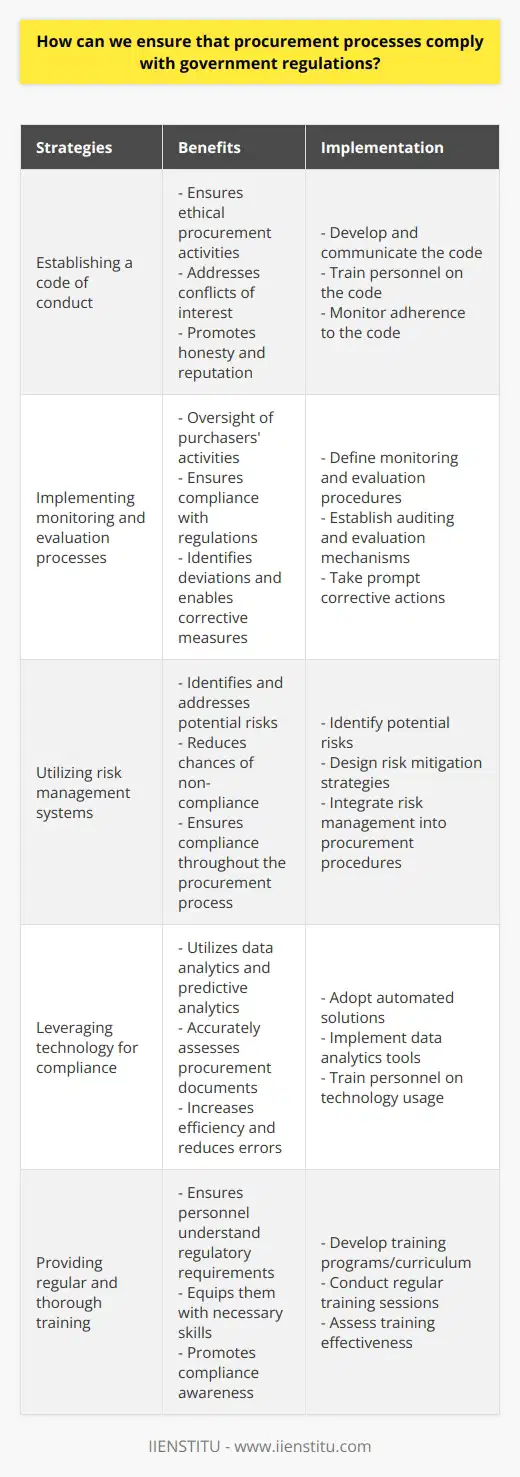
What elements should be taken into consideration when creating a procurement plan?
When creating a successful procurement plan, several vital elements must be considered. These elements include establishing clear goals, proper selection of vendors, comprehensive risk management, adequate cost control, and effective communication between all stakeholders.
The first element to consider when creating a procurement plan is the establishment of clear goals. The program should begin by setting out a specific vision for the project and identifying the desired outcomes the plan seeks to achieve. It is also essential that the plan outlines the specific needs and requirements for the project, such as timeline, budget, and scope. This will provide a solid foundation for the procurement strategy and ensure all stakeholders understand their objectives clearly.
The second element when creating a procurement plan is the proper selection of vendors. It is essential to research potential vendors and ensure they can meet the project requirements. Before selecting vendors, it is necessary to assess their capabilities and provide their offer is competitive. It is also essential to consider the vendors' history of successful completion of similar projects and their customer service level.
Thirdly, comprehensive risk management is necessary for a procurement plan to be successful. All risks should be identified and adequately mitigated, considering the potential costs and timelines involved. In addition, the program should include an effective escalation procedure in case the project should require additional resources or budgets.
Once the procurement plan has been established, adequate cost control is required to complete the project within the allocated budget. Therefore, it is necessary to monitor project costs throughout the entire project lifecycle and ensure that any changes are made with the project's best interests in mind.
Finally, effective communication between all stakeholders is essential to ensure the procurement plan is successful. All stakeholders should receive regular updates throughout the project lifecycle and be allowed to provide feedback and ideas. This will ensure that any issues are quickly identified and addressed and that all team members are on the same page.
In conclusion, these are the five key elements to consider when creating a successful procurement plan. By having a clear vision and goals, selecting the right vendors, conducting comprehensive risk management, controlling project costs, and establishing effective communication with stakeholders, the project team can ensure that the procurement plan will achieve its objectives.

What factors determine the 'right time' in procurement and how can they be anticipated?
Assessing Market Conditions
One crucial factor to consider when determining the 'right time' in procurement is the assessment of market conditions. By analyzing the demand and supply trends, procurement professionals can make informed decisions about the optimal time to purchase goods and services. For example, they may consider purchasing in bulk when prices are low, or postponing purchases when competition is high.
Supplier Relationship Management
Another aspect that influences the 'right time' in procurement is the management of supplier relationships. Establishing strong communication channels with suppliers enables procurement professionals to have a better understanding of the suppliers' capabilities, capacity, and production schedules. In turn, this enables them to anticipate possible delays or disruptions, allowing them to plan their procurement activities accordingly.
Economic Indicators
Analyzing economic indicators is an essential aspect of anticipating the 'right time' in procurement. By keeping an eye on factors such as inflation rates, currency fluctuations, and interest rates, procurement professionals can make strategic decisions about when to purchase and how to negotiate contracts. For instance, if the local currency is expected to appreciate in the short term, it might be wise to postpone procurement activities to take advantage of favorable exchange rates.
Seasonal Factors
Seasonal factors also play a role in determining the 'right time' for procurement. By understanding the cyclical nature of certain industries, procurement professionals can strategically time their purchases to coincide with low-demand periods, securing goods and services at more favorable prices. For instance, procuring winter clothing or construction materials during off-peak seasons could lead to substantial cost savings.
Risk Management
Lastly, effective anticipation of the 'right time' in procurement involves assessing and managing potential risks. Procurement professionals must consider factors such as political, social, and environmental risks that could impact their supply chains. By proactively addressing these risks, procurement teams can better anticipate the 'right time' to secure goods and services, ensuring that they maintain a stable and reliable supply chain.
In conclusion, the determination of the 'right time' in procurement can be influenced by various factors, including market conditions, supplier relationships, economic indicators, seasonal factors, and risk management. It is essential for procurement professionals to carefully consider all these elements to make strategic decisions that add value to their organizations and contribute to their overall success.
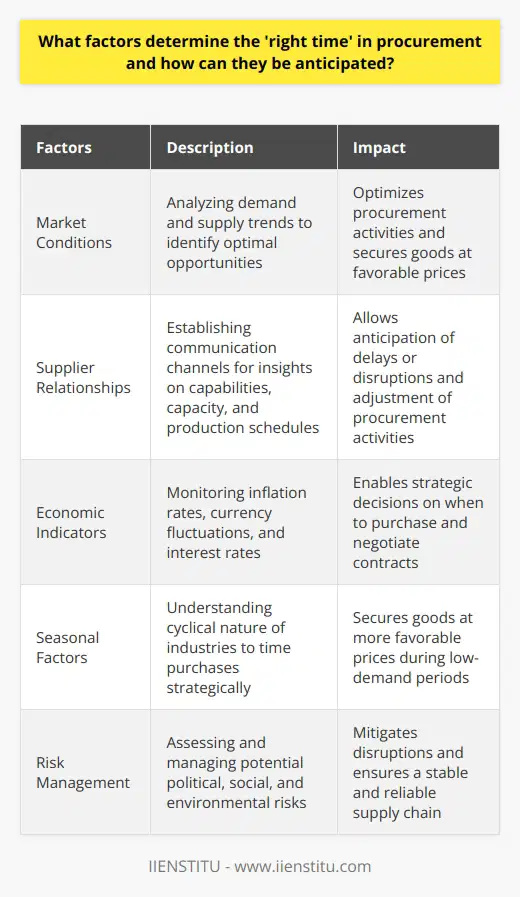
How do the 5 P's in procurement contribute to an organization's overall efficiency and effectiveness?
**Introduction to the 5 P's in Procurement**
Procurement, as a vital business function, contributes significantly to an organization's overall efficiency and effectiveness. The 5 P's (People, Process, Performance, Profit, and Planet) in procurement play a substantial role in achieving this contribution.
**People in Procurement**
The effectiveness of procurement starts with people. Recruiting skilled, experienced, and knowledgeable personnel is crucial for efficient procurement processes. These professionals contribute to the organization's growth by applying best practices, fostering relationships with suppliers, and helping the firm negotiate better deals.
**Process Optimization**
An efficient procurement process is critical for an organization's success. Streamlining processes, implementing standardized practices, and reducing waste contribute to a smoother procurement operation. Moreover, incorporating digital technologies and automation in procurement ensures better visibility and control, resulting in the organization's overall efficiency and effectiveness.
**Performance Measurement and Management**
Monitoring performance through Key Performance Indicators (KPIs) in procurement enables organizations to identify areas requiring improvement. Effective management of these KPIs promotes continuous improvement, contributing to the overall efficiency of procurement operations. Performance measurement techniques, like benchmarking, help organizations in comparing their performance against industry standards, leading to competitiveness and long-term growth.
**Profit Maximization**
The ultimate goal of any organization is to maximize profit. Efficient procurement practices play a critical role in achieving this goal by reducing costs, improving supplier quality, and mitigating risk. Cost reduction initiatives, prudent supplier selection, and contract management enable organizations to get the best value for money, leading to increased profitability.
**Planet-Sustainability and Procurement**
Organizations are increasingly recognizing the importance of sustainability and its impact on their bottom line. Sustainable procurement practices, such as using eco-friendly materials and collaborating with environmentally responsible suppliers, contribute to the organization's long-term success. This responsible approach generates goodwill from stakeholders, preserves the environment, and fuels overall efficiency and effectiveness.
**Conclusion**
In conclusion, the 5 P's in procurement collectively contribute to an organization's efficiency and effectiveness. By emphasizing the importance of people, processes, performance, profit, and planet, organizations can ensure a holistic approach to procurement that drives long-term success. Optimizing these five dimensions of procurement dramatically enhances an organization's ability to compete and thrive in the ever-changing business landscape.
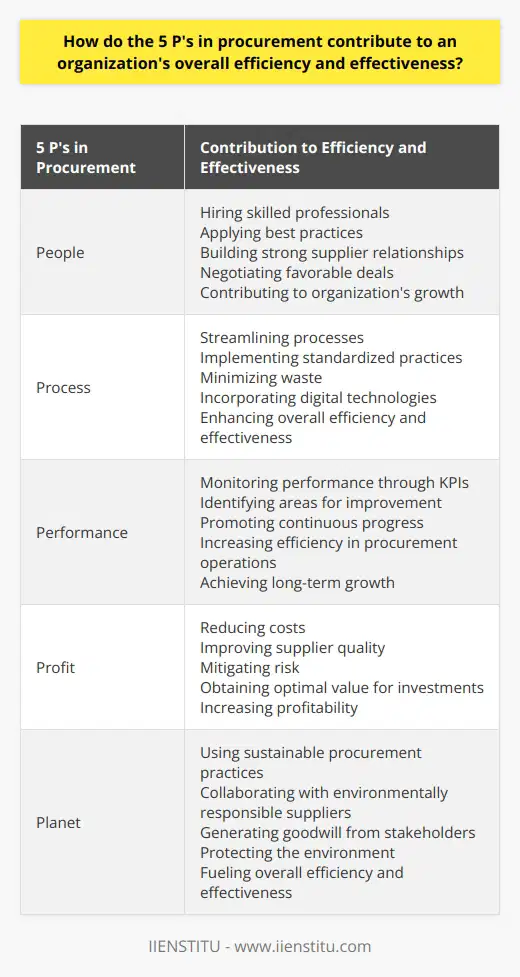
In what ways do adherence to the 7 principles of procurement lead to better decision-making and outcomes in procurement processes?
Adherence to Procurement Principles
One way adherence to the 7 procurement principles leads to better decision-making and outcomes in procurement processes is through proper planning. By ensuring an adequate preparatory phase, organizations can effectively determine their needs, specify clear objectives, and prioritize requirements. This initial planning ensures well-informed decisions, reducing the likelihood of costly mistakes.
Transparency and Open Communication
Adopting transparency in procurement processes fosters an environment of trust among stakeholders. By openly sharing information, organizations can improve collaboration and reduce misunderstandings. Clear communication throughout the procurement process helps ensure that relevant market information is obtained and considered, enhancing the decision-making process and leading to better outcomes.
Equality and Fairness
Ensuring equality and fairness in procurement practices contributes to better decision-making. By treating all potential suppliers fairly and providing them equal opportunity to submit bids, organizations can attract a diverse range of suppliers, thereby increasing competition. This competitive environment drives down costs and encourages innovation, resulting in better procurement outcomes.
Cost-efficiency and Effectiveness
Focusing on cost-efficiency and effectiveness is vital for achieving successful procurement results. Employing a value-for-money approach, organizations can analyze both qualitative and quantitative factors when selecting suppliers. This comprehensive evaluation method fosters well-informed decisions that drive better procurement outcomes, allowing organizations to maximize their resources.
Risk Management
Proactively managing risks is crucial for successful procurement processes. By identifying and mitigating potential issues before they escalate, organizations can prevent adverse effects on procurement outcomes. Furthermore, effective risk management enables better decision-making by helping organizations make well-informed choices that carefully balance risk and reward.
Ethics and Compliance
Adhering to ethical standards and regulatory compliance ensures the integrity of procurement processes. Organizations that prioritize ethics and compliance demonstrate their commitment to responsible sourcing, enhancing their reputation and credibility within the market. This ethical approach contributes to informed decision-making and promotes long-term, mutually beneficial relationships between organizations and their suppliers.
Continuous Improvement
Embracing continuous improvement principles encourages organizations to learn from their experiences and refine their procurement processes. By actively seeking feedback and evaluating past performance, organizations can identify areas for improvement, leading to more effective decision-making and better procurement outcomes in the future.
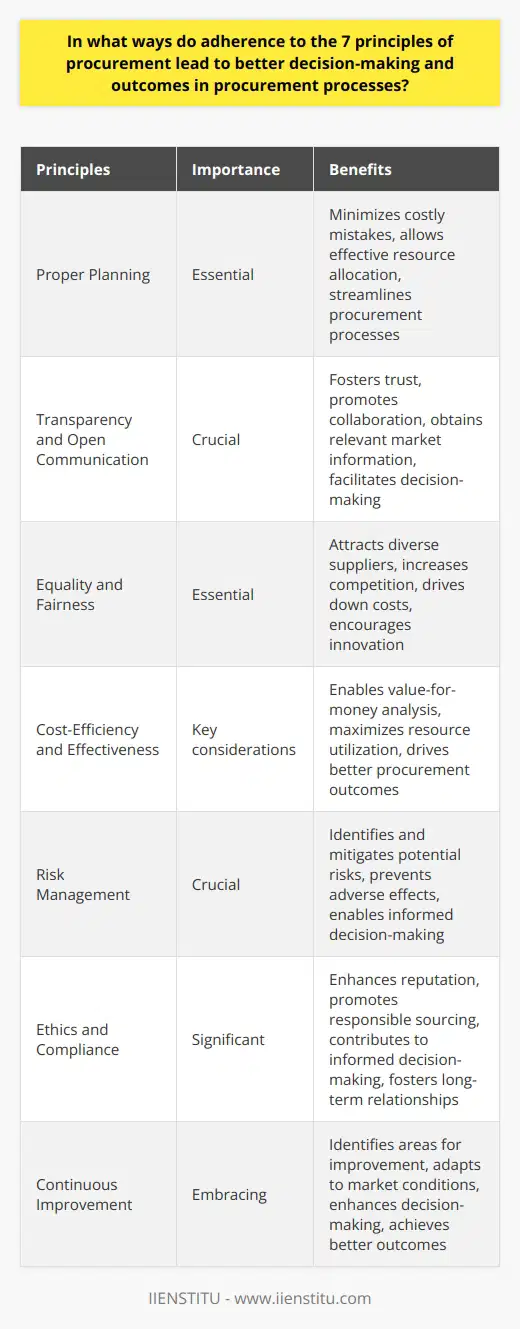
Why is right time important in procurement?
Significance of Right Timing in Procurement
Effective timing in procurement is essential for several reasons, directly impacting an organization's efficiency and success. First, let us understand the role timing plays in procurement before discussing its importance.
Synchronization with Business Needs
Proper alignment of procurement activities with the organization's business requirements leads to significant cost savings and increased efficiency. Timely procurement ensures that products or services are acquired when necessary, reducing the risks of inventory or service gaps and mitigating potential business disruptions.
Impact on Supplier Negotiations
Initiating procurement processes at the right time enhances an organization's negotiation power with suppliers. Early engagement with suppliers allows for a thorough assessment of available options, fostering healthy competition and enabling organizations to secure favorable pricing and terms.
Influence on Lead Times
Right timing in procurement reduces the lead time – the interval between placing an order and receiving the goods or services. Efficient timing minimizes the risk of delays due to unforeseen supply chain disruptions, ensuring continuity of business operations.
Budget Considerations
Accurate timing allows organizations to allocate resources judiciously, avoiding last-minute budget fluctuations that may stem from unforeseen procurement expenses. By incorporating strategic procurement planning, organizations can optimize cash flow management and ensure cost-effective decision-making.
Quality Control
When procurement processes are initiated with ample time, organizations can thoroughly assess the quality of products or services they are procuring. This enables informed decision-making, ensuring that quality standards are met or exceeded without compromising the timeline or budget constraints.
Risk Mitigation
Effective timing reduces the risk of supply chain disruptions, project delays, and cost overruns. It allows businesses to anticipate and address potential issues that may arise during the procurement process, such as supplier performance, currency fluctuations, or changing market conditions.
In conclusion, the importance of right timing in procurement cannot be understated. Timely procurement ensures that organizations can optimize their resources, achieve cost savings, maintain quality control and mitigate risks, ultimately driving efficiency and success in today's competitive business landscape.
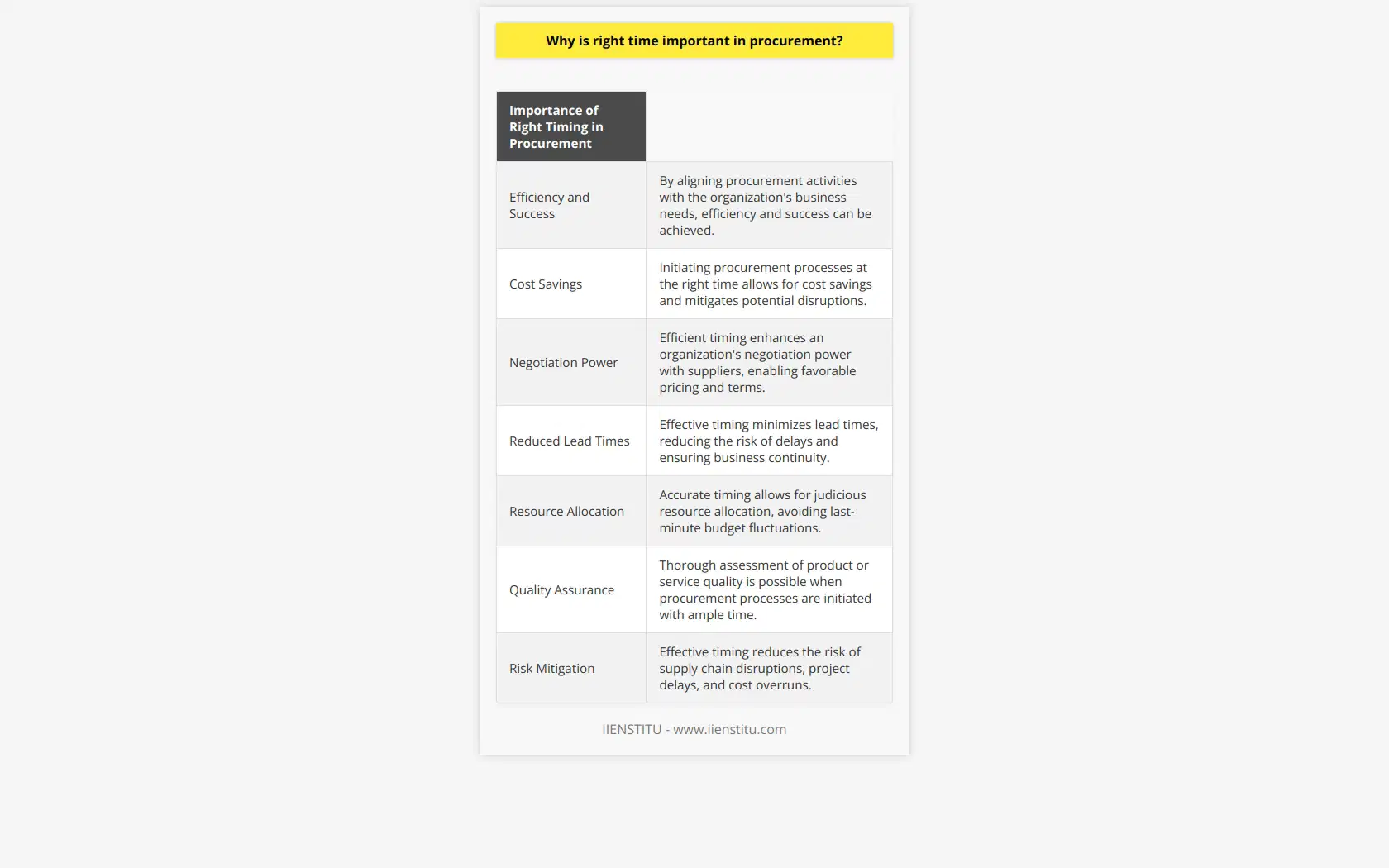
How can you ensure the right time in procurement?
**Understanding Procurement Timing**
Ensuring the right time in procurement involves a thorough understanding of the procurement process, strategic planning, and effective communication. By establishing clear requirements, setting deadlines, and employing monitoring tools, organizations can optimize procurement timing and make informed decisions.
**Establishing Clear Requirements**
The first step in ensuring the right time in procurement is to define and communicate clear requirements. Understanding the organization's needs, their associated priority levels, and available resources helps create realistic expectations. Additionally, this step enables the procurement team to coordinate with suppliers and other stakeholders effectively.
**Setting Deadlines**
Developing a comprehensive schedule with achievable deadlines is crucial to ensure the right time for procurement. Procurement teams must establish timelines that coordinate with project milestones and resource availability. Moreover, these deadlines must be communicated transparently to all stakeholders, ensuring accountability and encouraging collaboration.
**Employing Monitoring Tools**
Organizations can utilize various procurement management and monitoring tools to track their procurement activities, ensuring timely progress. These tools help in identifying potential bottlenecks and deviations from the established schedule, enabling swift corrective actions. As a result, organizations can effectively avoid delays and ensure efficient procurement processes.
**Effective Communication**
Fostering open channels of communication among procurement teams, suppliers, and other stakeholders is essential in ensuring the right time in procurement. Regular communication helps in addressing concerns and potential issues before they escalate, thus maintaining the procurement schedule. Additionally, effective communication facilitates information sharing, which leads to informed decision-making and ultimately, timely procurement.
**Continuous Improvement**
Adopting a continuous improvement approach enables organizations to refine their procurement processes continually. By evaluating each procurement cycle, procurement teams can identify inefficiencies and areas of improvement. This practice promotes the optimization of procurement time, ensuring that the right decisions are made at the right time.
In conclusion, ensuring the right time in procurement is an ongoing effort that requires a deep understanding of the process, strategic planning, and effective communication. By implementing these strategies, organizations can optimize their procurement timing and ultimately enhance their operational efficiency.
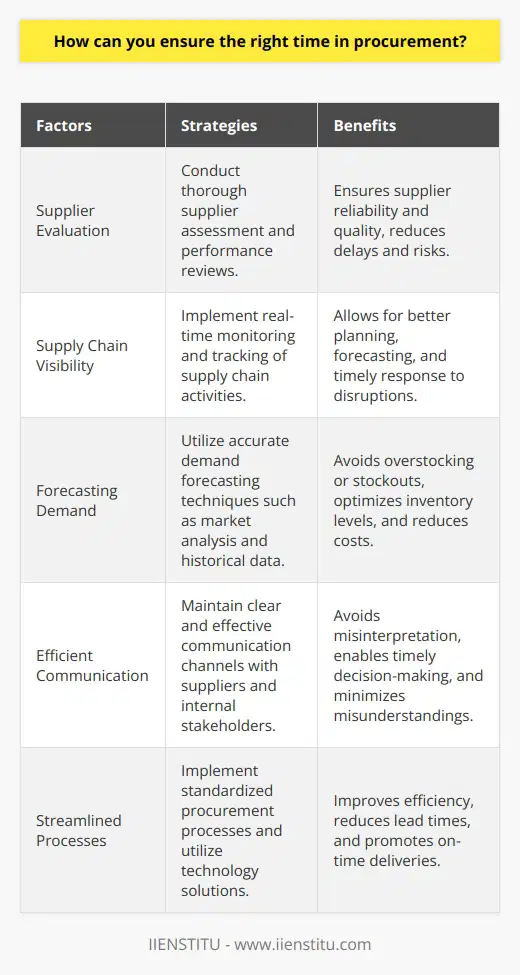
What are the 5 R's in procurement?
The 5 R's in Procurement
Right Quality
The first 'R' in procurement refers to the right quality, which entails ensuring that procured goods or services meet the required specifications. This denotes that procurement professionals must comprehend and ascertain the quality standards expected and demonstrate meticulousness in upholding these criteria throughout the procurement process.
Right Quantity
The second 'R' is the right quantity, which means procuring the precise amount of goods or services demanded, neither more nor less. This aspect demands precise forecasting and inventory management to prevent excess stock that can lead to increased holding costs, obsolescence, and waste, or understock that might cause production delays and loss of business opportunities.
Right Time
Acquiring goods and services at the right time constitutes the third 'R' in procurement. This revolves around effective planning, lead-time assessment, and punctual delivery of procured items. The right time is crucial to prevent interruptions in production, to satisfy customer demand, and to ensure rapid response to shifts in the marketplace.
Right Source
Identifying and selecting the right source or supplier is the fourth 'R' in procurement. It requires thorough research, evaluation, and negotiation with prospective suppliers to obtain the ideal combination of cost, quality, and timely delivery. Negotiating contracts and building robust relationships with suppliers reinforce a resilient and responsive supply chain.
Right Price
Lastly, the right price involves achieving optimal cost-effectiveness in procured goods and services without sacrificing quality. This demands skilled negotiation, comprehensive market research, and cost analysis techniques to ascertain the most reasonable prices. The right price also considers the total-cost-of-ownership, which includes lifecycle costs, transportation, and other associated fees.
In conclusion, the 5 R's of procurement emphasize the importance of procuring the right quality, quantity, time, source, and price. Adhering to these principles enhances the efficiency and effectiveness of the procurement process, resulting in a more competitive and successful organization.
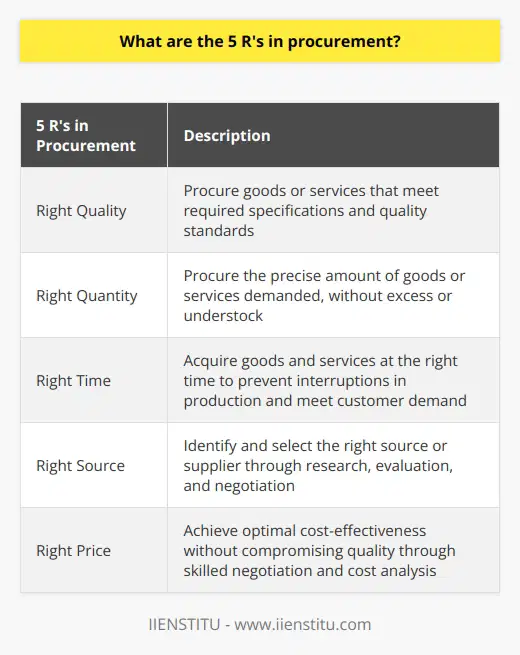
What are the 7 principles of procurement and how do they impact an organization's procurement strategy?
Principle of Ethics and Fair Dealing
The principle of ethics and fair dealing demands honesty, fairness, and integrity in transactions. It impacts an organization's procurement strategy by enhancing credibility, trustworthiness, and corporate reputation, which can strengthen supplier relationships.
Principle of Competition
The principle of competition aims at achieving the best value for money. It leads to cost-effective procurement strategies, promotes supplier diversity, and prevents biased supplier selection or favoritism.
Principle of Demand Aggregation
The principle of demand aggregation focuses on consolidating similar requirements across the organization. It improves the procurement strategy by leveraging bulk buying, achieving economies of scale, and reducing procurement costs.
Principle of Life cycle Costing
This principle advocates for considering all costs associated with the product's lifetime and not just the initial acquisition cost. It makes procurement strategies more sustainable and cost-efficient in the long run.
Principle of Procurement Planning
The principle of procurement planning suggests systematic and forward-looking approaches to procurement. This principle makes the procurement strategy more organized, predictable, and prevents last-minute purchases, thereby reducing risks.
Principle of Transparency and Accountability
This principle emphasizes open, well-documented, and auditable procurement processes. It bolsters an organization's procurement strategy by ensuring fairness, enhancing stakeholder confidence, and preventing corruption.
Principle of Best Supplier Performance
The principle of best supplier performance encourages selecting suppliers based on their performance, reliability, and quality, and not just their prices. It affects the procurement strategy by ensuring high-quality goods and services, which supports the organization's overall performance.
In conclusion, the seven procurement principles significantly shape an organization's procurement strategy in various ways, and conscientiously applying them promotes cost-effectiveness, transparency, quality, and overall business success.

How do the 5 R's in procurement contribute to minimizing risks and optimizing resources within an organization?
Risk Identification
In procurement, the first R, Risk Identification, promotes vigilant awareness about potential risks associated with a particular procurement activity. This enhances preventive measures, hence minimizes risks.
Rigorous Evaluation
Rigorous Evaluation, the second R, enables an organization to conduct comprehensive assessments of potential suppliers. Through this deep analysis, an organization optimizes its resources by partnering with the most suitable suppliers and prevents potential risks.
Regulatory Compliance
The third R, Regulatory Compliance, ensures an organization adheres strictly to all relevant laws, rules and guidelines related to procurement activities. This not only minimizes legal risks but also promotes financial stability by avoiding fines and potential lawsuits.
Reliable Contracting
Reliable Contracting, as the fourth R stresses the necessity of legally binding contracts with suppliers. Contracts protect both the organization and the supplier from potential risks, and hence, maintain resource optimization by ensuring expected deliverables.
Repetitive Evaluation
Lastly, Repetitive Evaluation emphasizes constant scrutiny of the procurement process, which is crucial. Regular audits and reviews help organizations identify and rectify any inefficiencies or risks in real-time.
Therefore, the five R's in procurement contribute to risk minimization and resource optimization, ensuring smooth, efficient processes within an organization. By clarifying potential risks and highlighting areas of improvement, these measures lead to more efficient resource distribution, maximizing the return on investment in procurement activities.
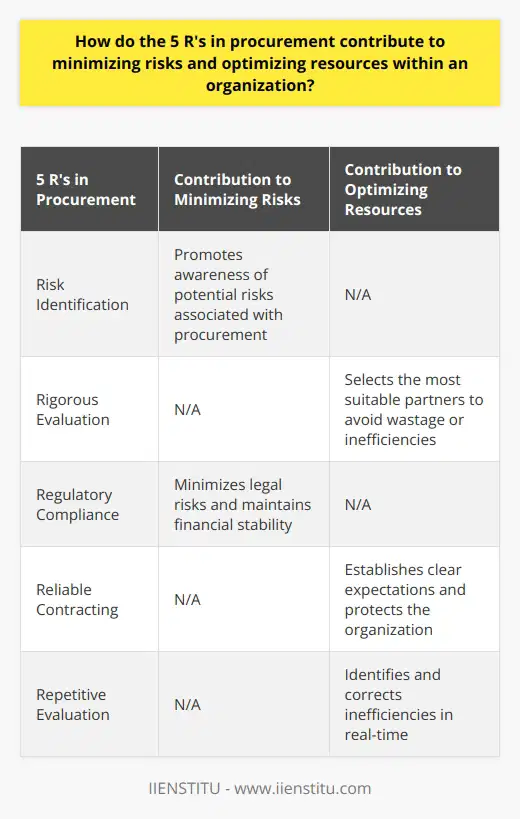
In the context of procurement, how can data analysis and forecasting techniques be utilized to determine the optimal time for making purchasing decisions?
Optimizing Timing through Data Analysis
In the realm of procurement, data analysis can effectively help plan purchasing decisions. Data on price trends, demands, and supplier behavior are indispensable elements to consider. Using a data analysis method like predictive modeling can project future price trends. Analyzed data helps identify when costs are likely to decrease, allowing companies to plan for purchase at the optimal cost.
Benefiting from Demand Forecasting
Likewise, forecasting techniques such as demand forecasting play a significant role in selecting the best time to make purchases. Examining past sales data provides insights into buying patterns and consumer behavior. With the aid of artificial intelligence, precise predictions of future demand are possible. Here, a company can set its procurement strategy to coincide with lower demand periods. This strategy can often secure products at a lower price and keep costs down.
Using Supplier Behavior Insights
Furthermore, data analysis encompasses the behavior of suppliers, a crucial aspect. Evaluating supplier performance over time helps identify the most reliable and cost-effective suppliers. Companies can thereafter plan their purchases to coincide with times that these top-performing suppliers offer discounts or promotions.
In conclusion, integrating data analysis and forecasting techniques provides procurement teams with strategic insights. With this foresight, companies can pinpoint the most advantageous times to make purchasing decisions. Investing in the right data analysis and forecasting tools thus opens avenues for substantial savings and efficiency in procurement.
